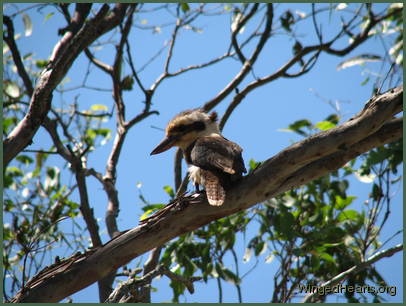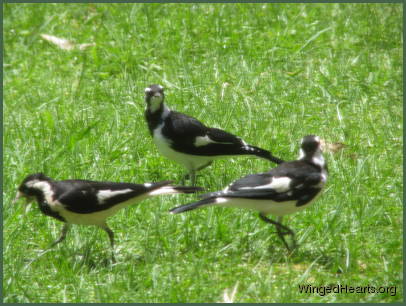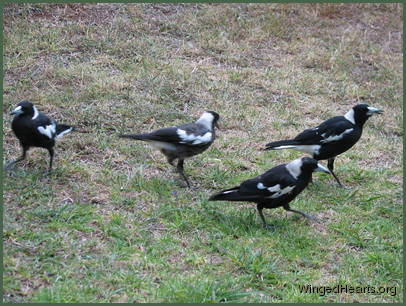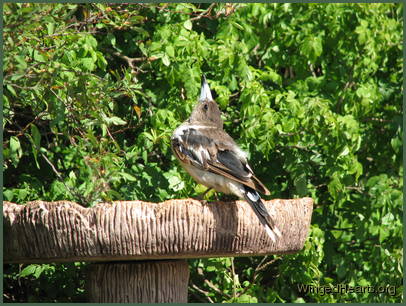Submitted by Gitie on 19 June, 2010 - 00:15
 Wild Birds love communicating with each other, with birds from other species, with other animals and they absolutely love talking to humans. They may fly off in a flurry at the very start because they may not be sure of your intentions, or they may befeeling particularly shy or self-conscious. But once they realise that you are sincerely interested in them, they begin to respond and take an interest in you.
Wild Birds love communicating with each other, with birds from other species, with other animals and they absolutely love talking to humans. They may fly off in a flurry at the very start because they may not be sure of your intentions, or they may befeeling particularly shy or self-conscious. But once they realise that you are sincerely interested in them, they begin to respond and take an interest in you.
Once one bird gets the idea and starts

Submitted by Gitie on 18 June, 2010 - 00:14
Every bird has its own unique personality, likes and dislikes. Some are extroverts and like socialising. Others are shy and feel more comfortable with just one or two friends, preferring to sit quietly by themselves till the crowds have gone. Some are bold and daring, ready to try new things. Some love singing and will croon loudly. Some never stop chirping and have much to say, while others will have their regular chat-times in the day when they will sit in their favourite nook and chortle. And some are bossy, and lose no time in sending the others off to their bidding. There will always be some bird who is in alarmist, crying wolf at the smallest shadow and sending others off in a frenzy.
The best way to observe them is at the water bath. Their behaviour and sound will give you many clues about their personality.

Submitted by Gitie on 16 June, 2010 - 01:46
In the first three parts we examined three key features we can use to recognise birds from a distance. The fourth way that I am going to tell you about today is one of my favourites, but it does require the birds to be close enough for detailed observation. Another way would be to use a pair of binoculars.
The method I'm talking about is to look at their plumage patterns. Like our fingerprints, the feathers of each bird forms a distinctive pattern.
Look at the three peewees in the picture below. At first glance you may think that they all look the same. But look again more carefully at the details of the black white feathers and you will three separate patterns.


Submitted by Gitie on 15 June, 2010 - 00:10
In the previous posts we looked at two methods of recognising individual birds:
1. Using shape, form and size, and
2. Using their general characteristics.

In this post we'll examine another useful technique namely, identifying them from their posture and movement.
Birds are much like humans in this regard. Not only do they have unique physical features, shape and form - each bird also moves as uniquely as does each human being.

Submitted by Gitie on 14 June, 2010 - 00:11
Today we continue to look at the key features that enable us to recognise individual birds.
Once our eyes get used to the differences in the shapes and sizes of the birds in a species. We can start training ourselves to look for more distinguishing characteristics.
- Look at the top of their heads? Does the bird have a smooth or fuzzy head? Is it more round or slightly flat?
- Does the bird have a crest, if so how big is it?
- Then look at their shape of the wings. Do they sag or are they folded tightly?

- Does the right wing cross over the left, or the other way round or do they meet nicely in the centre?
- Look at the patterns of colour around their faces, necks, chests, backs, legs and wings. In the examples below you will see the shapes are different for each bird, even though at first glance the birds appear to be similar.
- How long is their beak? What is the shape of their mouths?
- Do they have any distinguishing parks on their beaks and cheeks?
In the picture on the right (above), the shape of the mask around the eyes, under the chin as well as the marks where the beaks
meet the cheek are all individual characteristics. Renutu (noisy-miner) does not have a goatie in the centre of his mask unlike his sister Chipkin in the picture below.

Pages

 Wild Birds love communicating with each other, with birds from other species, with other animals and they absolutely love talking to humans. They may fly off in a flurry at the very start because they may not be sure of your intentions, or they may befeeling particularly shy or self-conscious. But once they realise that you are sincerely interested in them, they begin to respond and take an interest in you.
Wild Birds love communicating with each other, with birds from other species, with other animals and they absolutely love talking to humans. They may fly off in a flurry at the very start because they may not be sure of your intentions, or they may befeeling particularly shy or self-conscious. But once they realise that you are sincerely interested in them, they begin to respond and take an interest in you.









